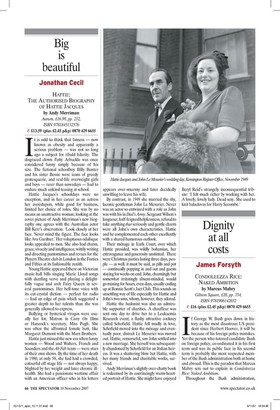Big is beautiful
Jonathan Cecil HATTIE: THE AUTHORISED BIOGRAPHY OF HATTIE JACQUES by Andy Merriman Attrum, £16.99, pp. 232, ISBN 9781845132576 £13.59 (plus £2.45 p&p) 0870 429 6655 1 t is odd to think that fatness — now known as obesity and apparently a serious problem — was not so long ago a subject for ribald hilarity. The disgraced clown Fatty Arbuckle was once considered funny simply because of his size. The fictional schoolboy Billy Bunter and his sister Bessie were icons of greedy grotesquerie, and real-life overweight girls and boys — rarer than nowadays — had to endure much unkind teasing at school.
Hattie Jacques's schooldays were no exception, and in her career as an actress her avoirdupois, while good for business, limited her choice of roles. She was by no means an unattractive woman; looking at the cover picture of Andy Merriman's new biography one agrees with the Australian actor Bill Kerr's observation: 'Look closely at her face. Never mind the figure. The face looks like Ava Gardner.' Her voluptuous odalisque looks appealed to men. She also had charm, grace, vivacity and intelligence; wittily writing and directing pantomimes and revues for the Players Theatre club in London in the Forties and Fifties at its fashionable zenith.
Young Hattie appeared there on Victorian music-hall bills singing Marie Lloyd songs with dazzling verve and playing a delightfully vague and arch Fairy Queen in several pantomimes Her bell-tone voice with its cut-crystal diction — perfect for radio — had an edge of pain which suggested a greater depth to her talents than she was generally allowed to express.
Bullying or hysterical viragos were usually her lot; Matron in Carty On films or Hancock's secretary, Miss Pugh. She was often the affronted female butt, like Margaret Dumont with the Marx Brothers.
Hattie just missed the new era when funny women — Wood and Walters, French and Saunders and the Ab Fab team — were stars of their own shows. By the time of her death in 1980, at only 58, she had had a crowded, colourful off-stage life — not always happy, blighted by her weight and later chronic illhealth. She had a passionate wartime affair with an American officer who in his letters appears over-smarmy and later decidedly unwilling to leave his wife.
By contrast, in 1949 she married the shy, laconic gentleman John Le Mesurier. Never was an actor so entwined with a role as John was with his in Dad's Amy. Sergeant Wilson's languour, half-feigned helplessness, refusal to take anything that seriously and gentle charm were all John's own characteristics. Hattie and he complemented each other excellently with a shared humorous outlook.
Their ménage in Earls Court, over which Hattie presided, was wildly bohemian, her extravagance and generosity unstinted. There were Christmas parties lasting three days, people — as well, it must be said, as pills and pot — continually popping in and out and guests staying for weeks on end. John, charmingly but somewhat irritatingly absent-minded, would go missing for hours, even days, usually ending up at Ronnie Scott's Jazz Club. This sounds an unsettling way of life especially for Hattie and John's two sons, whom, however, they adored.
Hattie the hedonist was also an admirable supporter of charities. A chauffeur was sent one day to drive her to a Leukaemia Research event, a flashy attractive cockney called Schofield. Hattie fell madly in love, Schofield moved into the ménage and eventually poor, distrait Le Mesurier was moved out. Hattie, remorseful, saw John settled into a new marriage. She herself was subsequently abandoned by Schofield for an Italian heiress. It was a shattering blow but Hattie, with her many friends and charitable works, survived.
Andy Merriman's slightly over-chatty book is redeemed by its convincingly warm-hearted portrait of Hattie. She might have enjoyed Beryl Reid's strangely inconsequential tribute: 'I felt much richer by working with her. A lovely, lovely lady. Dead sexy. She used to knit balaclavas for Harry Secombe.'





































































 Previous page
Previous page